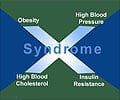A new study found out how metabolic risk factors cluster similarly in children and adults

The study showedthat the components of metabolic syndrome cluster similarly in children and adults of differentages irrespective of sex. However, abdominal obesity was relatively less emphasised in childrenthan in adults, and increased blood pressure was relatively more emphasised in middle-aged menthan in children and older men and women. As expected, the risk factor score was higher inadults than in children. The observed cumulation of metabolic risk factors in all age groupsincreased the risk of premature death due to type 2 diabetes, myocardial infarction andcardiovascular diseases in adults.
The results indicate that also metabolic risk factorscores lower than those generally accepted in the field of medicine are detrimental especiallyin cases where several risk factors are present. The results suggest that risk assessment oftype 2 diabetes and cardiovascular diseases should increasingly pay attention to the scores ofseveral risk factors. Furthermore, lifestyle interventions begun in childhood and continuinginto adulthood, combined with drug treatment when necessary, should constitute the primarymethod of reducing the overall risk.
The data comprised three population samples from theKuopio region in eastern Finland: 491 healthy 6-8 year old girls and boys participating in thePhysical Activity and Nutrition in Children (PANIC) Study, 1,900 middle-aged men participatingin the Kuopio Ischaemic Heart Disease Risk Factor Study (KIHD), and 1,170 older women and menparticipating in DR's EXTRA Study. The PANIC Study is an on-going lifestyle intervention study,which produces valuable information on children's lifestyle factors, health and well-being allthe way into adulthood. Collaboration between the three different studies involving people ofdifferent ages made it possible to study the development of metabolic syndrome and its riskfactors extensively.
Source-Eurekalert












